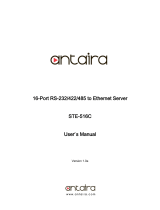
UDS2100 Device Server User Guide 8
List of Figures
Figure 2-1. Serial Tunneling Example______________________________________ 12
Figure 2-2. Direct TCP/IP or Redirector Configuration _________________________ 12
Figure 2-3. Product Label _______________________________________________ 14
Figure 3-1. UDS2100 Connected to Serial Device and Network _________________ 15
Figure 5-1. Web Manager Login Window ___________________________________ 24
Figure 5-2. Lantronix Web Manager _______________________________________ 24
Figure 5-3. Network Settings ____________________________________________ 25
Figure 5-4. Server Settings ______________________________________________ 28
Figure 5-5. Hostlist Settings _____________________________________________ 30
Figure 5-6. Channel Serial Settings _______________________________________ 31
Figure 5-7. TCP Connection Settings ______________________________________ 33
Figure 5-8. UDP Connection Settings ______________________________________ 36
Figure 5-9. Apply Settings and Apply Defaults _______________________________ 38
Figure 6-1. MAC Address _______________________________________________ 40
Figure 6-2. Setup Menu Options __________________________________________ 40
Figure 7-1. Network Settings ____________________________________________ 42
Figure 8-1. Serial Port Settings ___________________________________________ 45
Figure 8-2. Interface Mode ______________________________________________ 46
Figure 8-3. Hostlist Option ______________________________________________ 51
Figure 9-1. Expert Settings ______________________________________________ 60
Figure 9-2. Security Settings _____________________________________________ 62
Figure 10-1. TFTP Window ______________________________________________ 67
Figure A-1. Diagnostic, Power, and Serial Port LEDs _________________________ 73
Figure B-1. Serial Interface ______________________________________________ 77
Figure B-2. DB9 Male RS232 Serial DTE Connector __________________________ 77
List of Tables
Table 7-1. BootP/DHCP/AutoIP options ____________________________________ 42
Table 7-2. Standard IP Network Netmasks _________________________________ 43
Table 8-1. Interface Mode Options ________________________________________ 46
Table 8-2. Common Interface Mode Settings ________________________________ 46
Table 8-3. Flow Control Options __________________________________________ 47
Table 8-4. Reserved Port Numbers _______________________________________ 47
Table 8-5. Connect Mode Options ________________________________________ 48
Table 8-6. Manual Connection Address Example ____________________________ 50
Table 8-7. Modem Mode Messages _______________________________________ 53
Table 8-8. Modem Mode Commands ______________________________________ 54
Table 8-9. Disconnect Mode Options ______________________________________ 56
Table 8-10. Flush Mode Options __________________________________________ 57
Table 8-11. Pack Control Options _________________________________________ 57
Table 10-1. Firmware Files ______________________________________________ 66
Table 11-1. Monitor Mode Commands _____________________________________ 70
Table 11-2. Command Response Codes ___________________________________ 71
Table A-1. UDS2100 LEDs ______________________________________________ 73
Table A-2. Problems and Error Messages __________________________________ 74
Table C-1. UDS2100 Technical Specifications _______________________________ 80























